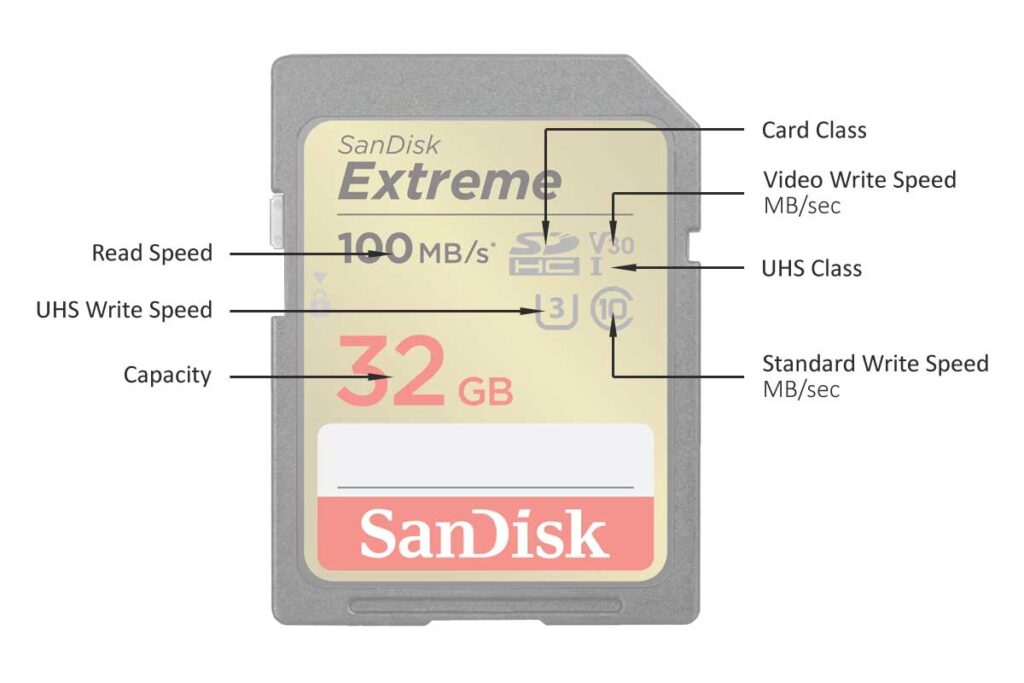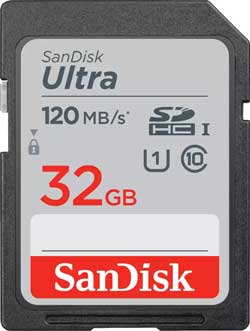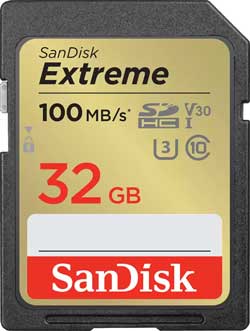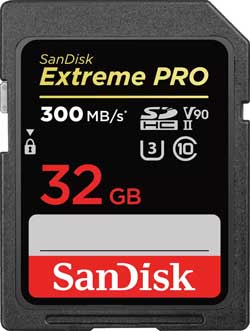SD Cards have become a somewhat overcomplicated topic. With so many SD Cards flaunting different types, classes, and speeds, it’s easy to buy the wrong card. And if you do, it may slow your camera’s performance or not work at all.
In SD Cards Explained, we’ll reveal the logic behind terms such as SDHC UHS-I, SDHC UHS-II, and SDXC and how you can apply this knowledge when buying your next SD Card. Jump to Conclusion.
Shop Now
Shop SD Cards in
Table of Contents
- SD Cards in Photography
- What is an SD Card
- SD Card Labeling Explained
- SD Card Classes Explained – SDHC vs SDXC
- SD Card Speeds Explained – UHS-I vs UHS-II
- SD Card Read Speed Explained
- SD Card Write Speed Explained
- SD Card Comparison
- SanDisk 32GB SDHC UHS-I
- SanDisk 32GB SDHC UHS-I
- SanDisk 32GB SDHC UHS-II
- Conclusion
SD Cards in Photography
SD Cards Explained is directed toward photography and videography. Nevertheless, the information in this post will help you choose the right SD Card for any device, whether it’s your card reader, smartphone, or laptop.
What is an SD Card
SD is short for Secure Digital and is a removable memory card for devices such as cameras, smartphones, and tablets. Despite strong competition, SD Cards have become the de facto standard for digital cameras, seeing-off alternatives such as Compact Flash, Sony’s Memory Stick, and Fuji’s XD cards.
SD Card vs SD Card
Unfortunately, an SD card is no longer just an SD Card. Although all SD Cards share the same form factor, there are different classes, read speeds, and write speeds. This means some SD cards will not work with your camera, despite fitting perfectly. And even if the SD Card works, the wrong card may reduce your camera’s performance.
Price
There’s also a huge disparity in price. For instance, a Sandisk SDXC UHS-II card costs $150 while a Sandisk SDXC UHS-I Card costs less than $20, despite both cards featuring 128 GB worth of storage. It’s also true that you may yield no benefit from buying the more expensive card. In fact, there’s even a chance it won’t work in your camera at all.
Which SD card do you buy?
Pay too little, and your cheaper SD Card may slow your camera’s performance. Pay too much, and your SD Card may exceed your camera’s performance or not work at all. Therefore, buying the right SD card requires browsing your camera’s manual and mastering a little jargon.
SD Card Labeling Explained

SD Card Classes Explained – SDHC vs SDXC
SD Cards are divided into four classes, the first being SD, with SDHC, SDXC, and SDUC coming later. The first of these 4 standards was SD and is only capable of storing 2GB worth of data. Whereas the latest standard, SDUC, will store up to 128TB.
Different SD Card Classes
 | SD stands for Secure Digital and contains up to 2 GB worth of storage |
 | SDHC – SDHC stands for Secure Digital High Capacity and stores between 2GB and 32GB’s worth of data |
 | SDXC – SDXC stands for Secure Digital Extended Capacity, which means between 32GB and 2 Terabytes. |
 | SDUC – The latest standard, Secure Digital Ultra Capacity, stores between 2TB and 128 TB |
SDHC vs SDXC
In practical terms, neither SDHC nor SDXC is better than the other. An SDXC has the potential to hold more data but isn’t necessarily any faster and could well be slower.
Compatibility
Given an SD Card’s capacity is clearly stated on its label – the only reason you should consider SD class is compatibility. For instance, my truly ancient Canon Powershot A620 will only run on standard SD cards as the A620 predates the release of newer SDHC and SDXC classes. On the other hand, my 2014 Nikon D750 supports SD, SDHC, and SDXC. But not SDUC.
SD Classes are backward compatible. If your camera can run an SDXC Card, it should also work with older classes such as SDHC and SD.
But remember, SD Classes are more about capacity than speed. Speed is another matter entirely.
SD Card Speeds Explained – UHS-I vs UHS-II
Your SD Card Speed is a measure of how much data your card can pass. As with the SD Card class, you should match your SD Cards Speed with your camera or device.
For instance, if your camera’s manufacturer recommends you use an SDXC UHS-II, I recommend you do too. Otherwise, you may reduce your camera’s performance or be unable to use the card at all.
There a 4 main SD Card Speed categories in photography; High Speed, UHS-I, UHS-II, and UHS-III
 | High Speed delivers up to 25 Megabytes per second. |
 | UHS stands for Ultra High Speed. UHS-I performs up to 104 MB per second. |
 | Ultra High-Speed II performs up to 312MB Per Second |
 | UHS III performs up to 624MB Per Second |
SD Card Read Speed Explained

Most SD Cards have their read speed printed on the label. For instance, it might be 90MB per second or 120MB per second. As you might expect, the faster the read speed, the quicker your camera or computer will be able to read or download your photos and video.
However, read speed is not everything. If your camera shoots 20 frames per second or 4K video, you need a card that can keep up. In other words, you need an SD Card with a fast Write Speed.
.
SD Card Write Speed Explained
An SD Card’s Write speed is critical for keeping up with your camera’s function. Modern-day features such as high-resolution raw files, ultra-fast continuous shooting, and 4K/8K video make Write speed more important than ever.
Write Speed is separated into three different classes, Speed classes, UHS Speed, and Video Speed classes, and are based on minimal continuous write speed.
Minimal Continous Write Speed
It’s important to recognize that Speed classes represent each card’s minimum continual write speed. In other words, a V30 card may vastly exceed 30 MB/sec in bursts but is specified to run at least 30 MB/sec continuously – an important consideration for burst shooting and video.

SD Card Speed Class Explained
Speed class is a simple number between 2 and 10, with 2 being the slowest. Given how cheap Class 10 cards are today, I recommend 10 as the bare minimum for high-resolution photography and high-definition 1080p video.
 | At least 2 Megabytes Per Second |
 | 4 Megabytes Per Second |
 | 6 Megabytes Per Second |
 | 10 Megabytes Per Second |
UHS Speed Class Explained
UHS cards are ranked as a 1 or a 3, with 3 being the fastest. Naturally, faster is better and more expensive, but there’s no point in buying a fast card for a slow low-spec camera or device.
| 10 Megabytes Per Second Minimum | |
| 30 Megabytes Per Second Minimum |
Video Speed Class Explained
With the rise of video in photography, SD Cards now come with a video rating between V6 and V90, with V6 being the slowest. Remember, these classes reflect the card’s minimal continuous write speed. So a V30 card can reliably write data continuously at 30 megabytes per second, which is important for video. But the card itself may be able to write much faster in short bursts, which is good for photography.
| 6 Megabytes Per Second Minimum | |
| 10 Megabytes Per Second Minimum | |
| 30 Megabytes Per Second Minimum | |
| 60 Megabytes Per Second Minimum | |
| 90 Megabytes Per Second Minimum |
SD Card Comparison
Here, we compare three 32GB SD cards ranging from $15 to $150 to determine which is best for our needs.

SanDisk 32GB SDHC UHS-I
This is the cheapest of our three 32GB SD Cards and can be read at 120 MB/s for faster downloads.
Otherwise, it’s a slow card. A Class 10 and UHS rating of 1 indicates a minimum continual write speed of 10 MB/Sec.
Therefore, this card is ample for slow-burst photography and average-quality 1080p video. But no more.

SanDisk 32GB SDHC UHS-I
Despite costing more than the first card, this SDHC UHS-I card has a slower read rate of 100MB/sec.
However, its V30 and UHS ‘3’ rating indicate a much faster minimal continual write speed of 30MB/Sec reaching 60MB/Sec in bursts.
This is a better card for shooting large files in bursts and recording 4K video.

SanDisk 32GB SDHC UHS-II
This is your top-tier option with up to 300MB/Sec read speeds and peak 260MB/Sec write speeds.
More importantly, this card’s V90 rating means it can write continually at a minimum of 90 MB/Sec.
This card is an ideal choice for the most demanding of cameras.
Conclusion
The SD Card market is hugely confusing, with customers expected to choose between variants such as SDHC UHS-II and SDXC UHS I. Furthermore, SD card labeling can be deceptive. For instance, the impressive 120MB/sec labeling refers to read rather than write speed and may actually be too slow for your camera.
Then there’s compatibility. Older cameras (and other devices) may be unable to run newer SD Card classes such as SDXC and SDUC. And even if it does, the new card classes refer to storage capacity rather than performance.
SD Card Performance
Therefore, performance is stated elsewhere. A class 10 card will deliver a minimum continuous write speed of 10 MB every second and often much more in shorter bursts. Modern labeling confuses matters further with separate ratings for UHS and Video write speeds though they’re all interlinked.
As always, price is a good indicator as you get what you pay for. And beyond price, the higher the number, the better. For instance, a class 10 card is faster than a class 2, a UHS rating of 3 is better than 1, and a video rating of V90 is more able than a V10 rated card.
That being said, spending a lot of money on a fast card only makes sense if your camera can utilize it. Otherwise, you’re paying for speed you cannot use.
Recommendations
When I began writing SD Cards Explained, I very much wanted to present a list of recommended cards by use case but was unable due to the significant number of variables.
For instance, recommending the best SD Card for video is very difficult due to the differences in resolutions, frame rates, and bit rates. As for photography, your needs will depend on your camera’s burst rate and the size of your files. After all, there’s a huge difference between a JPEG and an uncompressed raw file.
I also recommend you explore the specific model of SD card you wish to buy as a lot goes unsaid on the label. For instance, the Sandisk Extreme Pro is rated for a minimal continual data rate of 30 MB/sec. But the label doesn’t mention its 60 MB/sec peak performance. In other words, not all equally ranked SD cards are equal.
The end
As a result, I have to sign off this article in the most unsatisfactory way by referring you to your camera’s manual. But that aside, I hope this post helped you to understand the various abbreviations and ratings that litter your SD Card’s label, and perhaps, this is enough to help you with your next purchase. If you have any questions, please feel free to comment below.
Shop Now
Shop SD Cards in
